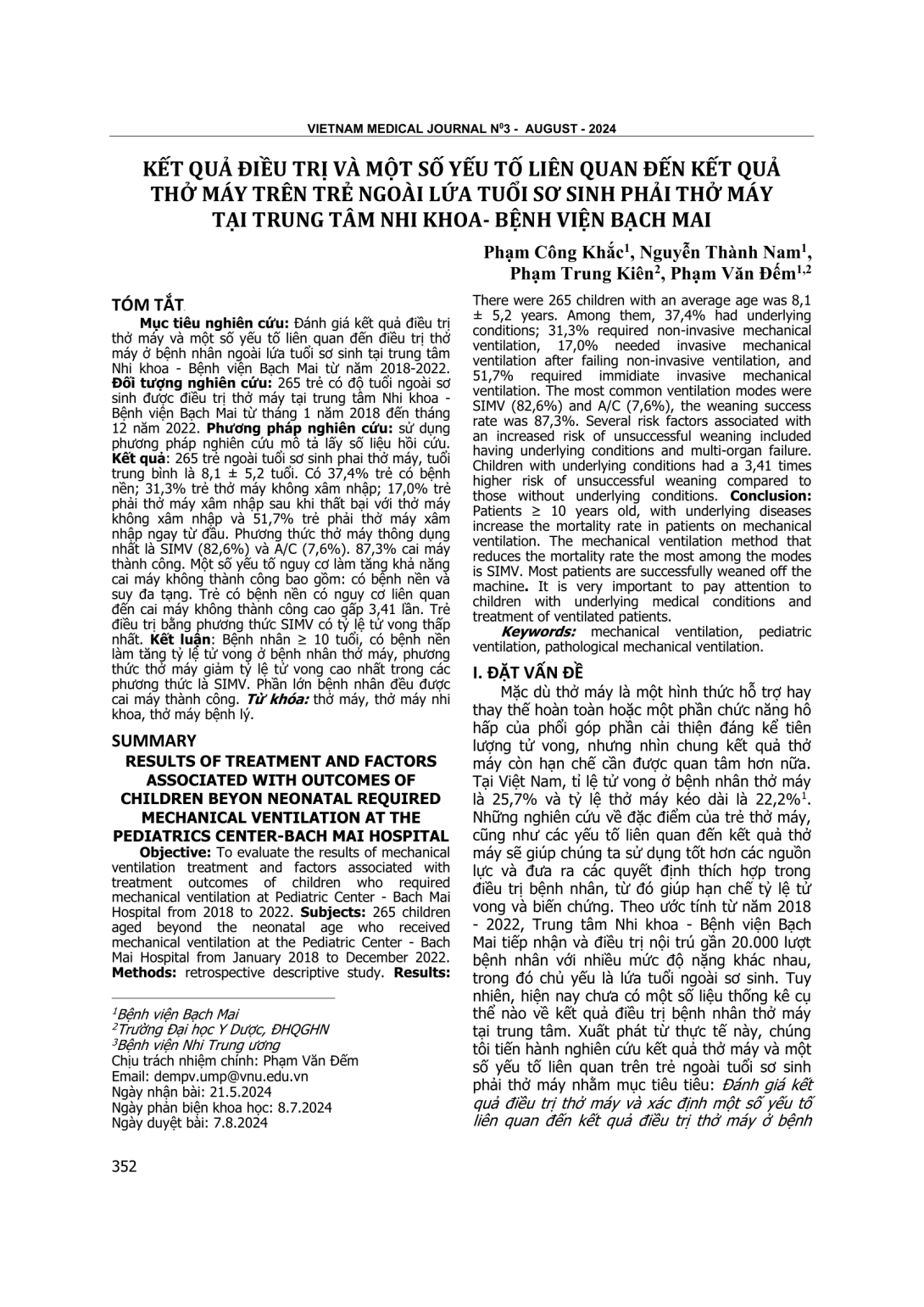
Đánh giá kết quả điều trị thở máy và một số yếu tố liên quan đến điều trị thở máy ở bệnh nhân ngoài lứa tuổi sơ sinh tại trung tâm Nhi khoa - Bệnh viện Bạch Mai từ năm 2018-2022. Đối tượng nghiên cứu: 265 trẻ có độ tuổi ngoài sơ sinh được điều trị thở máy tại trung tâm Nhi khoa - Bệnh viện Bạch Mai từ tháng 1 năm 2018 đến tháng 12 năm 2022. Phương pháp nghiên cứu: sử dụng phương pháp nghiên cứu mô tả lấy số liệu hồi cứu. Kết quả: 265 trẻ ngoài tuổi sơ sinh phai thở máy, tuổi trung bình là 8,1 ± 5,2 tuổi. Có 37,4% trẻ có bệnh nền; 31,3% trẻ thở máy không xâm nhập; 17,0% trẻ phải thở máy xâm nhập sau khi thất bại với thở máy không xâm nhập và 51,7% trẻ phải thở máy xâm nhập ngay từ đầu. Phương thức thở máy thông dụng nhất là SIMV (82,6%) và A/C (7,6%). 87,3% cai máy thành công. Một số yếu tố nguy cơ làm tăng khả năng cai máy không thành công bao gồm: có bệnh nền và suy đa tạng. Trẻ có bệnh nền có nguy cơ liên quan đến cai máy không thành công cao gấp 3,41 lần. Trẻ điều trị bằng phương thức SIMV có tỷ lệ tử vong thấp nhất. Kết luận: Bệnh nhân ≥ 10 tuổi, có bệnh nền làm tăng tỷ lệ tử vong ở bệnh nhân thở máy, phương thức thở máy giảm tỷ lệ tử vong cao nhất trong các phương thức là SIMV. Phần lớn bệnh nhân đều được cai máy thành công.
To evaluate the results of mechanical ventilation treatment and factors associated with treatment outcomes of children who required mechanical ventilation at Pediatric Center - Bach Mai Hospital from 2018 to 2022. Subjects: 265 children aged beyond the neonatal age who received mechanical ventilation at the Pediatric Center - Bach Mai Hospital from January 2018 to December 2022. Methods: retrospective descriptive study. Results: There were 265 children with an average age was 8,1 ± 5,2 years. Among them, 37,4% had underlying conditions; 31,3% required non-invasive mechanical ventilation, 17,0% needed invasive mechanical ventilation after failing non-invasive ventilation, and 51,7% required immidiate invasive mechanical ventilation. The most common ventilation modes were SIMV (82,6%) and A/C (7,6%), the weaning success rate was 87,3%. Several risk factors associated with an increased risk of unsuccessful weaning included having underlying conditions and multi-organ failure. Children with underlying conditions had a 3,41 times higher risk of unsuccessful weaning compared to those without underlying conditions. Conclusion: Patients ≥ 10 years old, with underlying diseases increase the mortality rate in patients on mechanical ventilation. The mechanical ventilation method that reduces the mortality rate the most among the modes is SIMV. Most patients are successfully weaned off the machine. It is very important to pay attention to children with underlying medical conditions and treatment of ventilated patients.
- Đăng nhập để gửi ý kiến
